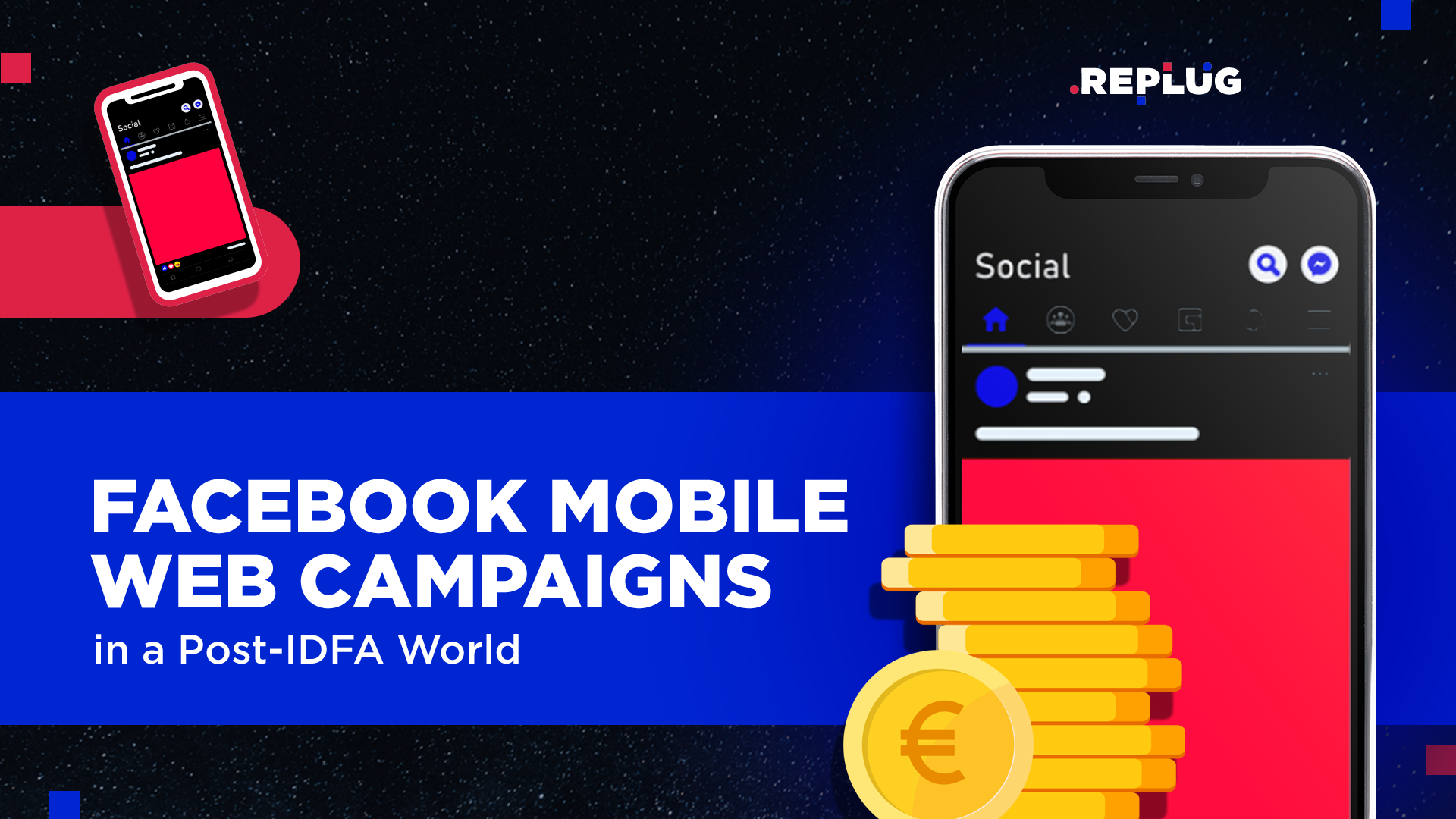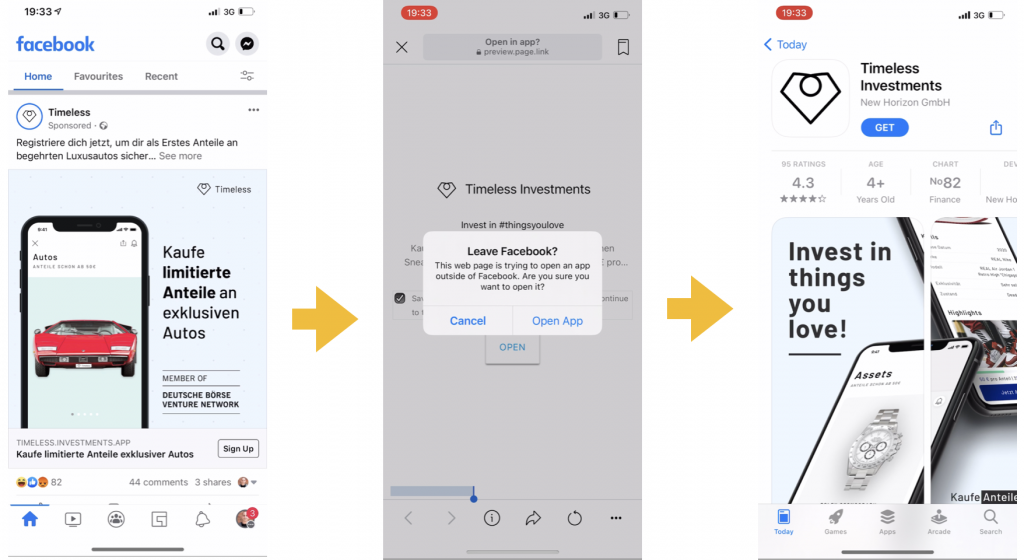Facebook Campaign Optimization in a Post-IDFA World

Mobile campaign optimization can now seem scary after the introduction of iOS 14. We are here to help you navigate these abrupt changes with our insights.
It’s been over a year since the announcement of iOS 14 and its ATT (AppTracking Transparency) implementation in the mobile app marketing world. Since then, many marketers have been actively trying to find a solution (or workarounds) to this earthquake.
The “old-school” deterministic approach to campaign optimization has been slowly falling apart, leaving some marketers clueless about tracking and correctly attributing their marketing dollars.
However, most discussions have focused on the impact this change had on mobile app campaigns. But what about acquisition activities on the mobile web?


What Do iOS 14 and ATT Mean for Mobile App Marketers?
Since iOS 14, many marketers have been trying to “heal” the attribution limitations by adding an extra step in the conversion funnel. They are doing so with an m-web landing page as an intermediate step to the download, or simply switching to mobile web campaigns, although this does not seem to be the ultimate solution to all our evils.
Although most marketers know what’s happening now, let’s take a step back and better understand what the ATT framework means for mobile marketers.
With iOS 14, Apple took a strong stance against the use of user data for marketing purposes. Facebook, above all, was in the middle of the earthquake as Apple took a clear stand against how the Social Network used users’ data to profit from advertising.
With the ATT framework, developers now have to get explicit consent for IDFA tracking. Specifically, if you have a mobile app with iOS 14, you have two options:
- Ask for clear permission (and hope users will give you the rights to be tracked)
- Don’t ask for anything and live in an anonymous world with no way to know how your marketing dollars are performing
What Has Happened to the Campaign Optimization?
As mentioned earlier, many marketers have hoped that web-to-mobile campaigns would have solved the tracking issues with a workaround Apple didn’t think about. However, Facebook—the most affected marketing network—made it clear that the ATT would have harmed both app and web campaigns.
“Businesses that advertise mobile apps, as well as those that optimize, target, and report on web conversion events from any of our business tools will be affected. As more people, opt-out of tracking on iOS 14 devices, ads personalization, and performance reporting will be limited for both app and web conversion events.”
Source
Although the information is abundant online about ATT’s impact on mobile campaign optimization on Facebook, there’s little about its impact on mobile web campaigns. Considering the current scenario and the uncertainty ahead of us, we have put together, simply and clearly, what happens to mobile web campaigns when a user opt-out of tracking.
Impact #1: Tracking
In a privacy-focused world, user targeting becomes more complicated. Marketers now have fewer means to optimize or retarget Bottom of Funnel (BoF) users.
In the pre-iOS 14 times, marketers could define targeting from the pixel as “Viewed, Added to Cart, Initiate Checkout, Purchase, and others.” Now, all this won’t be possible as users that opt out from ATT will not be visible. In addition, we won’t be able to exclude those users from our ad sets, increasing the complexity of campaign optimization.
The implications, however, reach far beyond the simple retargeting campaigns.
The Limitations
- Customer List audiences will have the same limitations. Even if we upload our customers’ list, Facebook will have to ignore those users who have opted out and serve the ad only to Android and opted-in iOS users.
- Lookalike audiences sourced from Pixel or Catalogue, both value-based or custom-based, will not be as efficient as in the past. The algorithm won’t have the data from opt-out users. Hence the size will decrease, and so will its effectiveness.
- Retargeting the engagements happening on Facebook and Instagram with actions such as “profile visits, video views, instant experiences, and shop views” will reach all the users. However, if opt-out Apple users convert to the website, attribution for a particular ad will be limited.
Interest-based and broad audience targeting will reach all users; however, similar to engagement retargeting, the particular ad attribution will be limited to opt-out Apple users.
Impact #2: Measurement and Reporting
iOS 14 has also considerably affected how Facebook and marketers analyze the user conversion funnel. Once users opt-out, it will be impossible to distinguish whether they are coming from organic or paid traffic. This will make it extremely difficult to report marketing campaigns’ effectiveness correctly.
A solution implemented by Facebook to overcome this new limitation was establishing the so-called Aggregated Event Measurement (or AEM) for web events. With AEM, advertisers would receive data from opt-out users only in a 1-day click attribution window, as opposed to the current campaign optimization setting of a 7-day click. The data, however, is limited and delayed, similar to what happens with the SKAd Network.
Although interesting, AEM has another vital limitation to consider. It will report only the highest priority event in the funnel (a consequence of iOS 14 and ATT), leaving marketers blind to some critical in-app actions that come before the main campaign objective.
Additional Limitations to the Measurement and Reporting
For example, let’s take an eCommerce mobile app, which is now redirecting users to the m-site, as a workaround to iOS14. At the ad set level now, the marketing manager will see only the event with the highest priority, let’s assume “purchase,” and not, for example, the “add to cart” one, adding a new level of complexity to the reporting.
On June 30, 2021, Facebook announced a new statistical model that will “estimate conversions” to sweeten the bitter pill for marketers. For the time being, it is unclear to what extent Facebook will attribute events in this way, as this might create further confusion on the level of data accuracy.
Although still unclear how all this will actually work, we need to say that this is the best that Facebook could have implemented in such a short time to improve ad and campaign optimization and scaling.
Impact #3: Conversion API (Or CAPI)
The Conversion API is a tool that lets marketers share key web and offline events, or custom actions, directly from the server to Facebook. In simple words, CAPI works together with our Facebook pixel to improve the performance and measurement of our Facebook ad campaigns.
For this reason, many marketers have thought this would be a viable alternative to overcome iOS 14 in reporting and targeting opted-out users. However, these users are still invisible to us, even to the Conversion API.
CAPI is a helpful tool for maintaining accurate, usable data and signal loss due to browser restrictions and ad blockers. However, it will not help us with opted-out iOS users since this tool is also subjected to AEM (Aggregated Event Measurement). Even if our server-side tracking posts back the data, Facebook will have to ignore users who disagree to be tracked.
“Events sent to Facebook via Conversion API will also be processed in accordance with limits set by Aggregated Event Measurement.”
Source
In Conclusion: If People Opt Out, They Opt-Out
iOS 14 poses some great questions about how we have been doing marketing and campaign optimization until today.
With Android 12, Google will follow Apple’s path, creating even more doubts about the future of performance and data-driven marketing. Moreover, marketers must reconsider how campaign optimization and targeting work. And, above all, how to report on their effort to scale paid user acquisition activities.
Too many marketers still ignore the effect of a change in user privacy. The shift from deterministic to probabilistic attribution will have a massive impact on campaign reporting and the way we decide where and how to spend our marketing budget. Because yes, we won’t just stop spending money on marketing.
The future of marketing is not doomed. We simply need to be updated and understand how to tackle new challenges. Traditional brands that are increasingly seeing a change from the web to mobile traffic have yet to understand what iOS 14 means, but the storm is already here, and we can’t just sit and wait for it to pass. The storm is here to stay.
Are you launching or entering a new market with your mobile app? Get in touch with our team of app marketing experts and start scaling now.
FAQ
How Do You Optimize a Marketing Campaign?
Here are some ideas for optimizing an app marketing campaign: understand your target audience thoroughly, use A/B testing, analyze your metrics, and prioritize conversions above leads.
What Is Optimization in Advertising?
Ad optimization is the process of developing ads that are relevant to the people that see them.
Then, optimizing these ads based on data gathered through A/B testing and user tests.
What Does IDFA Stand For?
An anonymized unique identifier stands for The Identifier for Advertisers—a mobile ad ID (MAID)—given to a user’s device by Apple that enables an installed smartphone app to monitor user activity across other businesses’ apps, webpages or offline assets for ad targeting, customization, and other purposes.
Originally published on August 30, 2021. Updated on May 23, 2022.